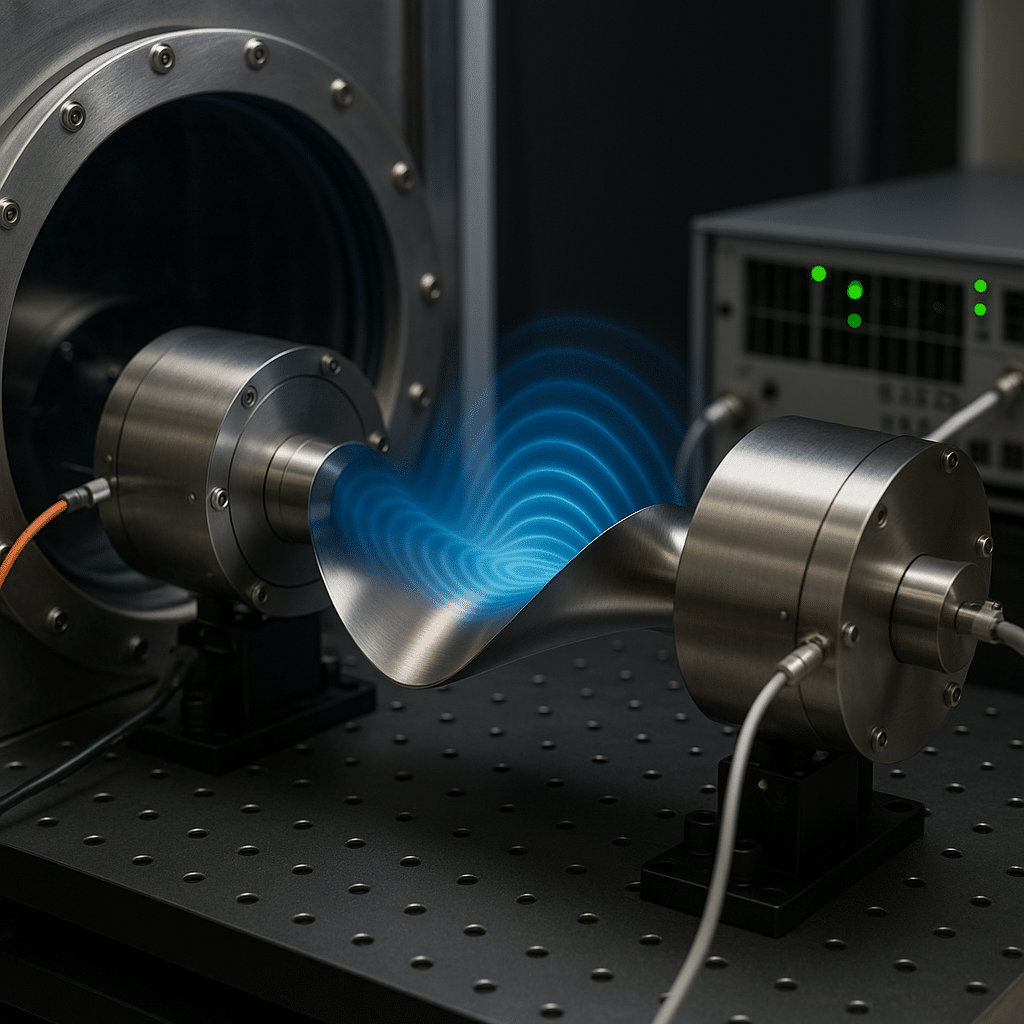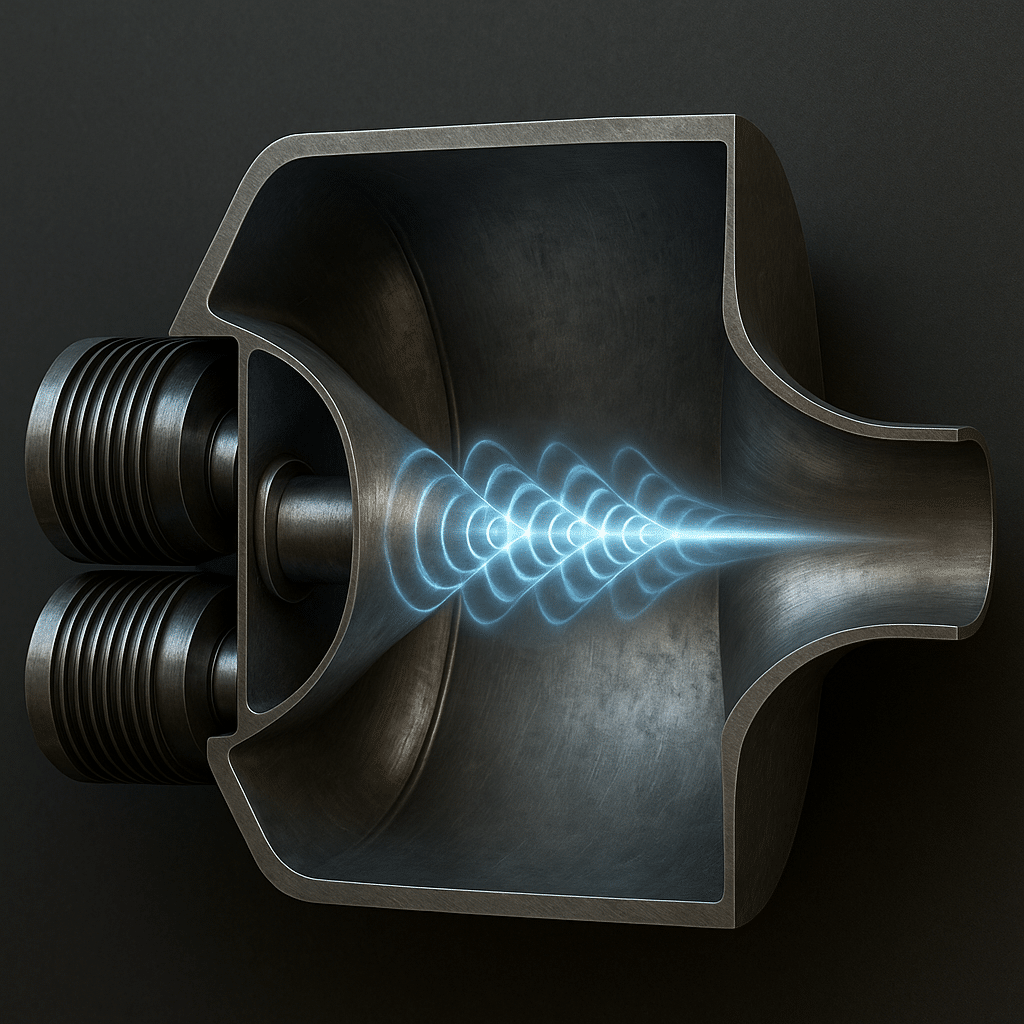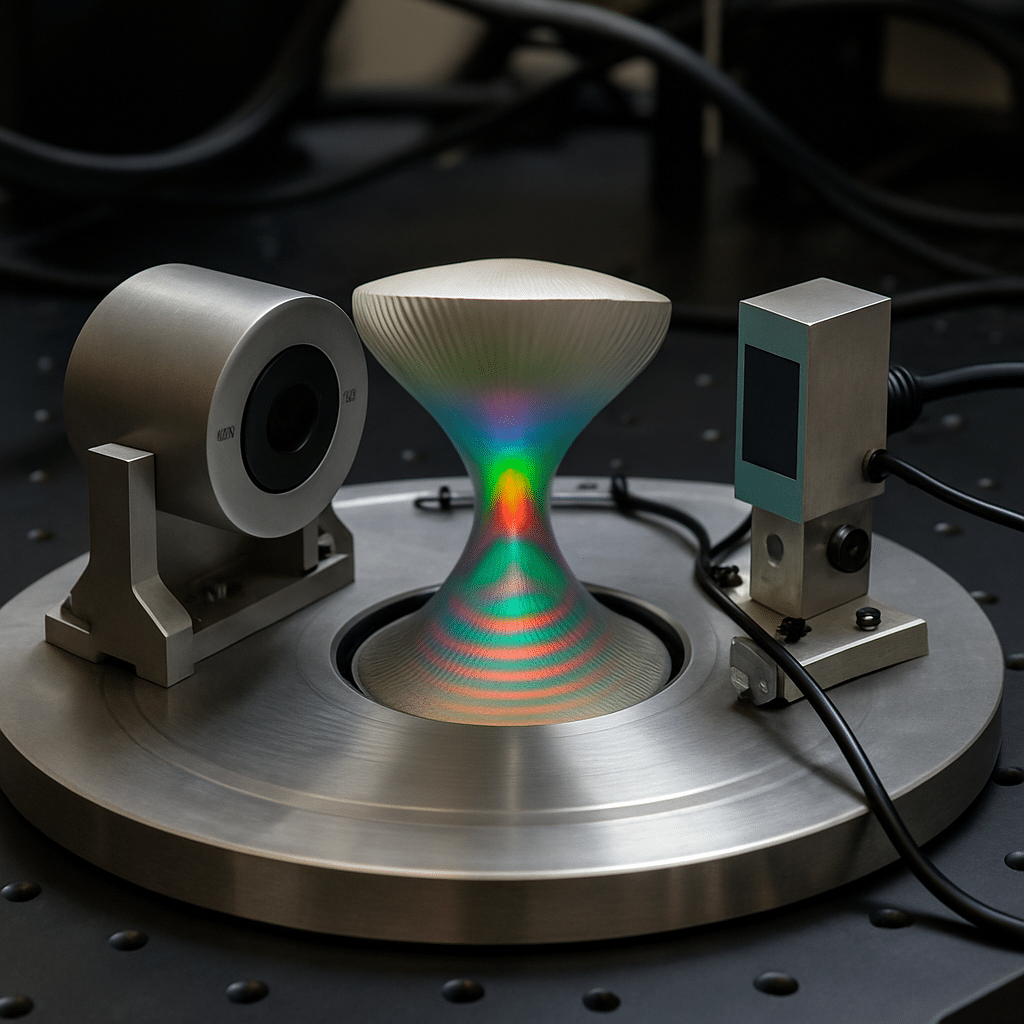Antigravity Engine by Wave Interference
An engine that pushes against nothing and yet moves—this page sets out how. Built on BeeTheory, which models gravity as a manipulable wave field, the concept uses phase-locked sources to sculpt an interference pattern whose crests act like moving ridgelines. The vehicle doesn’t throw mass; it leans on those crests. We call the control regime quantum surf. Below you’ll find the principle, the hardware, the control logic, the test plan, and the signatures that tell you it’s real or not. No equations—just engineering language and clear outcomes.
1) Why Wave Interference?
Think of gravity not as a static pull but as a dynamic medium carrying energy and momentum. If that’s true—and in BeeTheory we take it as our starting point—then interference becomes a handle. Two synchronized sources overlap; the overlap is not passive. With the right geometry and timing, it creates directional momentum flow inside the craft. Build a boundary that biases that flow, and the surface forces stop canceling. Net thrust appears. Flip the programmed phase and the thrust flips too. Simple idea, ruthless on tolerances.
2) Concept in Plain Terms
Two compact modules hum in lockstep. Their outputs meet and form a stable pattern of crests and troughs. Around them sits a shaped shroud—think of it as a gravito-metamaterial—that guides the energy the way a nozzle guides exhaust, except here the “exhaust” is a pattern inside the vehicle. A sensor suite watches the pattern in real time. A controller keeps the craft perched on the crest and the crest marching in the chosen direction. The craft surfs the wave it makes.
3) System Architecture
The engine isn’t one thing; it’s a choreography.
- Source modules: High-Q resonant units that cyclically modulate internal stress–energy. They must be spectrally narrow, phase-stable, and quiet.
- Phase-locking network: Low-jitter clocks and tuners that hold sub-cycle coherence under thermal and mechanical drift.
- Metamaterial shroud: A layered structure that breaks symmetry and funnels the internal momentum flow along the thrust axis. Geometry is destiny here.
- Quantum-surf controller: Real-time estimation of the crest location and motion, with continuous trimming of frequency, phase, and amplitude.
- Field sensors: Indirect probes (inertial, strain, differential accelerometers) arranged to reject electromagnetic and acoustic impostors.
- Isolation stack: Cryo or stabilized thermal stages, low-loss mounts, and inertial platforms to keep coherence intact.
4) Quantum Surf (Operating Regime)
Riding the crest is not a metaphor—it’s a control target. The controller synthesizes a picture of the local maximum from multiple sensors, then nudges the timing so the vehicle’s internal reference stays aligned with that moving peak. Short sentences matter here: track, align, correct. Longer time constants handle drift; fast paths suppress phase error. When lock is lost, the engine drops to a neutral pattern that produces negligible net force. When lock returns, thrust ramps back smoothly. The craft never “pushes off” the environment; it “pushes off” the pattern it sustains.
5) Performance Levers (What Actually Moves the Needle)
Frequency sets responsiveness and tolerance: higher is quicker but fussier. Source separation and effective aperture define the interference envelope and the leverage you get on directionality. Quality factor multiplies intensity for a given drive power, although it also makes you wait longer for spin-up. The shroud design dominates efficiency—tiny changes in curvature or lattice layout can change thrust-to-power by orders of magnitude. Coherence is the budget you spend every time you heat, bend, or vibrate anything.
6) Materials and Manufacturing
Start with ultra-low-loss resonators: single-crystal phononic structures, oxygen-clean superconductors, or ceramic stacks with extreme stiffness and minimal internal friction. Machine the shroud as if it were an optical component—surface finish and tolerance matter because the field is coherent. Cable plants and electronics live behind shielding; use fiber where you can. Thermal design is not a footnote: a few millikelvin per minute is the difference between hold and drift. Modularity helps—swap shrouds, swap sources, learn quickly.
7) Experimental Program (From Bench to Motion)
The path begins on a vacuum bench. Mount twin sources on a thermally regulated stage. Start with a symmetric shroud to establish a clean null; then install asymmetric shrouds that should produce thrust. Measure with a torsion balance capable of nanonewton resolution. Randomize phase schedules and blind the operators. Map thrust versus phase offset, drive level, frequency, and geometry. Watch for two non-negotiable signatures: a phase-reversal thrust flip and narrowband inertial lines at the drive and control sidebands. When the bench agrees, move to an air-bearing table or drag-free sled and demonstrate controlled translation with zero propellant.
8) What Counts as Evidence?
Not anecdotes; patterns. Directional force that reverses with programmed phase, persists under EM shielding, vanishes when coherence is broken, and scales with the parameters that theory says matter (aperture, asymmetry, drive power). Geometry swaps are decisive: a mass-matched symmetric shroud should kill directionality without touching the rest of the setup. Long-form runs should show flat thrust under temperature stability and predictable droop when you detune. If these signatures collapse under controls, the claim collapses with them. That’s healthy.

4) Quantum Surf (Operating Regime)
Riding the crest is not a metaphor—it’s a control target. The controller synthesizes a picture of the local maximum from multiple sensors, then nudges the timing so the vehicle’s internal reference stays aligned with that moving peak. Short sentences matter here: track, align, correct. Longer time constants handle drift; fast paths suppress phase error. When lock is lost, the engine drops to a neutral pattern that produces negligible net force. When lock returns, thrust ramps back smoothly. The craft never “pushes off” the environment; it “pushes off” the pattern it sustains.

5) Performance Levers (What Actually Moves the Needle)
Frequency sets responsiveness and tolerance: higher is quicker but fussier. Source separation and effective aperture define the interference envelope and the leverage you get on directionality. Quality factor multiplies intensity for a given drive power, although it also makes you wait longer for spin-up. The shroud design dominates efficiency—tiny changes in curvature or lattice layout can change thrust-to-power by orders of magnitude. Coherence is the budget you spend every time you heat, bend, or vibrate anything.

6) Materials and Manufacturing
Start with ultra-low-loss resonators: single-crystal phononic structures, oxygen-clean superconductors, or ceramic stacks with extreme stiffness and minimal internal friction. Machine the shroud as if it were an optical component—surface finish and tolerance matter because the field is coherent. Cable plants and electronics live behind shielding; use fiber where you can. Thermal design is not a footnote: a few millikelvin per minute is the difference between hold and drift. Modularity helps—swap shrouds, swap sources, learn quickly.
7) Experimental Program (From Bench to Motion)
The path begins on a vacuum bench. Mount twin sources on a thermally regulated stage. Start with a symmetric shroud to establish a clean null; then install asymmetric shrouds that should produce thrust. Measure with a torsion balance capable of nanonewton resolution. Randomize phase schedules and blind the operators. Map thrust versus phase offset, drive level, frequency, and geometry. Watch for two non-negotiable signatures: a phase-reversal thrust flip and narrowband inertial lines at the drive and control sidebands. When the bench agrees, move to an air-bearing table or drag-free sled and demonstrate controlled translation with zero propellant.
8) What Counts as Evidence?
Not anecdotes; patterns. Directional force that reverses with programmed phase, persists under EM shielding, vanishes when coherence is broken, and scales with the parameters that theory says matter (aperture, asymmetry, drive power). Geometry swaps are decisive: a mass-matched symmetric shroud should kill directionality without touching the rest of the setup. Long-form runs should show flat thrust under temperature stability and predictable droop when you detune. If these signatures collapse under controls, the claim collapses with them. That’s healthy.
9) Safety, Test Discipline, and Ethics
Default-to-neutral is the first rule: any control fault must dump the engine into a non-rectifying state. Containment next: test enclosures that prevent coupling to building structure and nearby instruments. Governance matters: preregistered protocols, external replication, and public raw data where security allows. Finally, recognize dual-use potential early; layer disclosures and export controls as performance rises.
10) Development Roadmap (Milestones You Can Check Off)
- Bench null and sanity checks with symmetric shroud; zero directionality under all phase schedules.
- First directional signature with an asymmetric shroud; thrust flips on 180° phase change.
- Vector control by steering the internal phase network; perform commanded slews on an air-bearing.
- Endurance and coherence over multi-hour runs with measured drift budgets.
- Packaged propulsion unit with standard interfaces and a documented thrust-to-power curve.
11) Executive Summary
The Antigravity Engine by Wave Interference treats gravity as a coherent field you can shape. Two or more synchronized sources create an internal interference pattern; a tailored shroud biases that pattern; a controller keeps the craft on the moving crest—quantum surf—so the net internal momentum flow becomes an external force. No propellant, no ambient medium, just phase, geometry, and discipline. The concept is testable, falsifiable, and engineered to be either compelling or ruled out by data.
FAQ
Q1: What exactly is BeeTheory?
BeeTheory is a wave-based model of gravitation that treats gravity as a physical field with energy and momentum flow that can be guided and interfered, much like acoustics or electromagnetism. In this framework, engineered interference is not just pretty—it does work.
Q2: Is this a “reactionless drive”?
No. The engine relies on internal momentum flow within a gravitational wave field. The apparent absence of exhaust is misleading; the pattern carries momentum, and the craft experiences the integrated reaction of that directed flow at its boundaries.
Q3: How is this different from electromagnetic tricks or acoustic pushes?
We design the experiment to reject them. Magnetic shielding, RF-quiet cabling, vacuum operation, and differential sensor layouts remove EM and acoustic coupling. Crucially, swapping a symmetric for an asymmetric shroud should toggle directionality without changing mass, EM properties, or drive electronics.
Q4: Does this violate conservation laws or general relativity?
Conservation is respected: momentum resides in the directed field pattern. Regarding GR, BeeTheory emphasizes a wave-field view compatible with Lorentz symmetry in the weak, engineered regime. The program is empirical: if the signatures appear and pass controls, they stand; if not, they don’t.
Q5: What are the hard parts?
Coherence, by far. Holding sub-cycle phase under thermal drift and micro-vibration is unforgiving. Boundary geometry is next—tiny deviations can erase rectification. Finally, metrology: you must measure nanonewtons honestly in a noisy world.
Q6: What power levels are we talking about?
Power translates to field intensity only through high-Q, low-loss hardware. The roadmap targets small, unambiguous forces first rather than absolute efficiency. Expect modest electrical power but extreme demands on stability and materials.
Q7: Can this work in vacuum and space?
Yes. The mechanism does not rely on air or external media. In fact, high vacuum improves coherence and metrology.
Q8: What constitutes a clean falsification?
Break phase coherence deliberately and watch directionality collapse. Replace the asymmetric shroud with a symmetric twin and see thrust vanish. Randomize phase schedules and demand that the force signature disappear under those conditions. If it doesn’t behave that way, the hypothesis fails.
Q9: How soon could a mobile demo exist?
After a robust bench detection and geometry-dependent replication. The schedule is dictated by coherence and materials, not calendar optimism.
Q10: Is it safe to test?
Yes, with standard laboratory precautions and engine-neutral fail-safes. Because the field is engineered to remain inside the test article, the primary risks are thermal, mechanical, and electrical—not environmental coupling.
